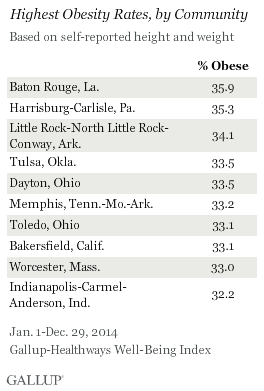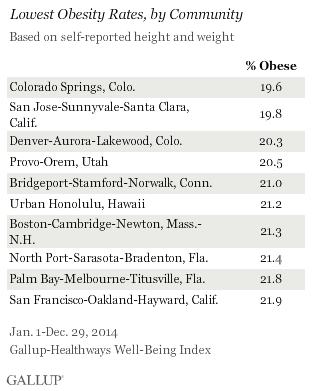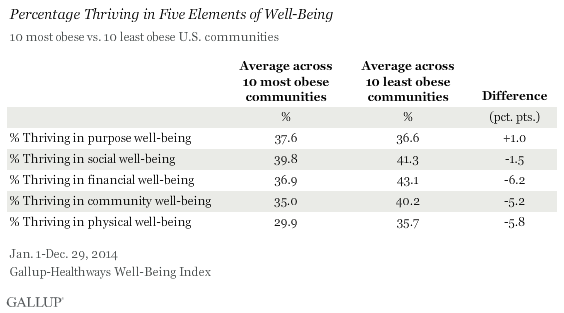Colorado Springs Residents Least Likely to Be Obese
Reposted with permission from Gallup
Gallup and Sharecare determine obesity rates using self-reported height and weight to calculate each respondent’s body mass index (BMI). Americans with a BMI of 30 or higher are considered obese. Nationally, the obesity rate continued to climb in 2014 to 27.7%, up from 27.1% in 2013 and much higher than the 25.5% found in 2008.
Obese Metro Areas Lag Behind in Financial and Community Well-Being
While obesity is clearly tied to lower physical well-being and a higher risk of health problems such as high blood pressure, diabetes, high cholesterol, chronic pain and depression, Gallup and Sharecare also discovered that Americans who are obese are more likely to have lower purpose, social, financial and community well-being than those who are not obese, even after taking key demographic variables into account.
Residents of the 10 communities with the highest obesity rates have much lower financial well-being than those living in the 10 communities with the lowest obesity rates. For instance, those living in the most obese communities are much more likely to worry about money and struggle to afford food and healthcare. These findings are consistent with previous Gallup and Sharecare research showing that obesity is linked to long-term unemployment and lower incomes.
Additionally, those living in communities with the highest obesity rates have much lower community well-being scores than those residing in communities with the lowest obesity rates. Residents of the former are significantly less likely to be proud of their community and to be satisfied with the city or area where they live.
Bottom Line
As the percentage of obese adults in the U.S. continues to rise, a wide disparity in obesity rates still exists between the communities with the highest rates and those with the lowest. In communities with the highest obesity rates, about one in three residents are obese. In communities with the lowest rates, about one in five residents are obese.
Previous Gallup and Sharecare research shows that obesity appears to be more common in smaller communities than large ones. This means that less populated communities, which are not represented in this analysis, could have obesity rates even higher than the 35.9% found in the Baton Rouge metro area.
In addition to obesity being linked to an increased risk of many chronic diseases, carrying extra pounds also appears to be detrimental to other areas of individuals’ well-being. For local government and business leaders, the finding that communities with high obesity rates also have lower financial and community well-being scores may be particularly concerning. The most obese communities may have higher percentages of residents burdened with healthcare costs associated with treating obesity-related illnesses, which could have a ripple effect on the broader economy. And if residents in the most obese areas have lower community well-being, crime levels could rise and businesses may move elsewhere.
Government and business leaders at the local level can develop targeted interventions for residents that build upon their community’s strengths and help address its weaknesses to make choosing healthy food and exercising regularly easy and accessible.
Read the full report on obesity in the 100 most populous U.S. communities.
SURVEY METHODS
Results are based on telephone interviews conducted as part of the Gallup-Sharecare Well-Being Index survey Jan. 2-Dec. 29, 2014, with a random sample of 176,702 adults, aged 18 and older, living in metropolitan areas in the 50 U.S. states and the District of Columbia, selected using random-digit-dial methods. Unlike previous years, only the 100 most populous metros — as determined by the U.S. Census Bureau — were reported in 2014. A second requirement is that at least 300 cases are required per metro area for reporting. As such, McAllen-Edinburg-Mission, Texas, and Durham-Chapel Hill, North Carolina, were both excluded from reporting because of insufficient sample size. These were replaced by the 102nd-largest metropolitan statistical area (MSA) in the U.S.: Lancaster, Pennsylvania.
The “communities” referenced in this article are based on MSAs as defined by the U.S. Office of Management and Budget. In many cases, more than one city is included in the same MSA. The San Jose, California, MSA, for example, also includes the smaller nearby cities of Sunnyvale and Santa Clara in addition to San Jose. Each respondent is attributed to his or her MSA based on self-reports of his or her ZIP code.
Maximum margins of error for the Well-Being Index and the element scores vary according to MSA size, ranging from less than 1 point for the largest cities represented to around ±1.5 points for many of the smallest cities.
All reported margins of sampling error include computed design effects for weighting.
Each sample of national adults includes a minimum quota of 50% cellphone respondents and 50% landline respondents, with additional minimum quotas by time zone within region. Landline and cellular telephone numbers are selected using random-digit-dial methods.
Learn more about how the Gallup-Sharecare Well-Being Index works.


